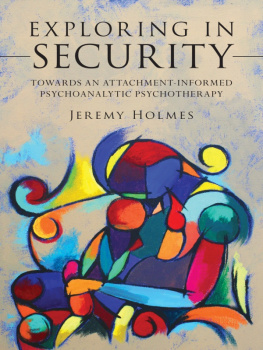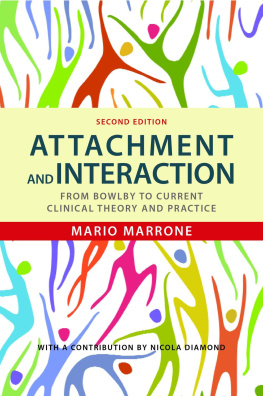John Bowlby and Attachment Theory
John Bowlby is one of the outstanding psychological theorists of the twentieth century. This new edition of John Bowlby and Attachment Theory is both a biographical account of Bowlby and his ideas and an up-to-date introduction to contemporary Attachment Theory and research, now a dominant force in psychology, counselling, psychotherapy and child development.
Jeremy Holmes traces the evolution of Bowlby's work from a focus on delinquency, material deprivation and his dissatisfaction with psychoanalysis's imperviousness to empirical science to the emergence of Attachment Theory as a psychological model in its own right. This new edition traces the explosion of interest, research and new theories generated by Bowlby's followers, including Mary Main's discovery of Disorganised Attachment and development of the Adult Attachment Interview, Mikulincer and Shaver's explorations of attachment in adults and the key contributions of Fonagy, Bateman and Target. The book also examines advances in the biology and neuroscience of attachment.
Thoroughly accessible yet academically rigorous, and written by a leading figure in the field, John Bowlby and Attachment Theory is still the perfect introduction to attachment for students of psychology, psychiatry, counselling, social work and nursing.
Jeremy Holmes worked for 35 years as a consultant psychiatrist and medical psychotherapist in the National Health Service. He is currently visiting professor at the University of Exeter, UK, where he set up a Doctoral programme in psychoanalytic psychotherapy. In 2009, he received the prestigious Bowlby-Ainsworth Award for his contributions to the field of attachment.
Makers of Modern Psychotherapy
This series of introductory, critical texts looks at the work and thought of key contributors to the development of psychodynamic psychotherapy. Each book shows how the theories examined affect clinical practice, and includes biographical material as well as a comprehensive bibliography of the contributor's work.
The field of psychodynamic psychotherapy is today more fertile but also more diverse than ever before. Competing schools have been set up, rival theories and clinical ideas circulate. These different and sometimes competing strains are held together by a canon of fundamental concepts, guiding assumptions and principles of practice.
This canon has a history, and the way we now understand and use the ideas that frame our thinking and practice is palpably marked by how they came down to us, by the temperament and experiences of their authors, the particular puzzles they wanted to solve and the contexts in which they worked. These are the makers of modern psychotherapy. Yet despite their influence, the work and life of some of these eminent figures is not well known. Others are more familiar, but their particular contribution is open to reassessment. In studying these figures and their work, this series will articulate those ideas and ways of thinking that practitioners and thinkers within the psychodynamic tradition continue to find persuasive.
Laurence Spurling
Titles in the series
John Bowlby and Attachment Theory
Second edition
Jeremy Holmes
Frances Tustin
Sheila Spensley
Michael Fordham: Innovations in Analytical Psychology
James Astor
The Clinical Thinking of Wilfred Bion Joan
Symington and Neville Symington
Heinz Kohut and the Psychology of the Self
Allen M. Siegel
Harry Stack Sullivan: Interpersonal Theory and Psychotherapy
F. Barton Evans III
R. D. Laing and the Paths of Anti-Psychiatry
Zbigniew Kotowicz
Anna Freud: A View of Development, Disturbance and Therapeutic Techniques
Rose Edgcumbe
Jacques Lacan and the Freudian Practice of Psychoanalysis
Dany Nobus
John Bowlby and Attachment Theory
Second edition
Jeremy Holmes
Second edition published 2014
by Routledge
27 Church Road, Hove, East Sussex, BN3 2FA
and by Routledge
711 Third Avenue, New York, NY 10017
Routledge is an imprint of the Taylor & Francis Group, an informa business
2014 Jeremy Holmes
The right of Jeremy Holmes to be identified as author of this work has been asserted by him in accordance with sections 77 and 78 of the Copyright, Designs and Patents Act 1988.
All rights reserved. No part of this book may be reprinted or reproduced or utilised in any form or by any electronic, mechanical, or other means, now known or hereafter invented, including photocopying and recording, or in any information storage or retrieval system, without permission in writing from the publishers.
Trademark notice: Product or corporate names may be trademarks or registered trademarks, and are used only for identification and explanation without intent to infringe.
First edition published by Routledge 1993
British Library Cataloguing in Publication Data
A catalogue record for this book is available from the British Library
Library of Congress Cataloging in Publication Data
Holmes, Jeremy, 1943
John Bowlby and attachment theory / Jeremy Holmes. Second edition.
pages cm. (Makers of modern psychotherapy)
1. Attachment behavior in children. 2. Bowlby, John. 3. Psychotherapy. 4. Attachment behavior. I. Title.
BF723.A75H65 2014
155.418dc23
2013026407
ISBN: 978-0-415-62902-7 (hbk)
ISBN: 978-0-415-62903-4 (pbk)
ISBN: 978-1-315-87977-2 (ebk)
Typeset in Times
by Swales & Willis Ltd, Exeter, Devon, UK
Contents
PART I
Origins
PART II
Attachment Theory
Part III
Implications
Figures
Tables
The origins of this book can be traced to a phone call from Laurie Spurling asking me about whom I would like to write. John Bowlby sprang instantly to mind so I must start by acknowledging my gratitude to Laurie for that invitation, and for his subsequent editorial help and suggestions.
The next without whom is to the Wellcome Trust, who granted me a six-month Research Fellowship which enabled me to concentrate exclusively on the book, free from my clinical and administrative responsibilities. Sabbaticals are becoming rare enough in universities, and in the National Health Service are almost unheard of. Mine was a blissful period which not only enabled me to devote myself to the book, but also provided a perspective from which I realised how stressful and exhausting most NHS consultant posts are. So the Wellcome has saved me from burn-out (or postponed it for a while) as well as enabling the book to get written. Never was a psychotherapist so professionally indebted to a pharmaceutical firm!
Next I must express my gratitude to my colleagues in the Department of Psychiatry at North Devon District Hospital, and especially to Doctors Roberts, Sewell and Van Buren, who gave their blessing to my absence, even though it meant more work for them; also to Dr Simon Nicholson, who cheerfully and efficiently took my place while I was away.
I am grateful to the Institute of Psychoanalysis for granting me access to their archives.
Much gratitude is due to the many friends and colleagues who have taken time and effort to discuss Attachment Theory, and those who have read all or part of the manuscript and have made many helpful suggestions which have improved its quality: Anthony Bateman, Mary Boston, Peter Fonagy, Dorothy Heard, Matthew Holmes, Sebastian Kraemer, Brian Lake, Richard Lindley, Pat Millner, Oliver Reynolds, Glenn Roberts, Charles Rycroft, Anthony Storr, and Robert and Lorraine Tollemache. To these, in 2013, I must add Arietta Slade, Peter Fonagy, and Mary Target, Howard Steele, Everett Waters, Maurice Eagle, Richard Mizen, and Jeremy Safran. Needless to say, the defects of the book remain entirely my responsibility.
Next page














